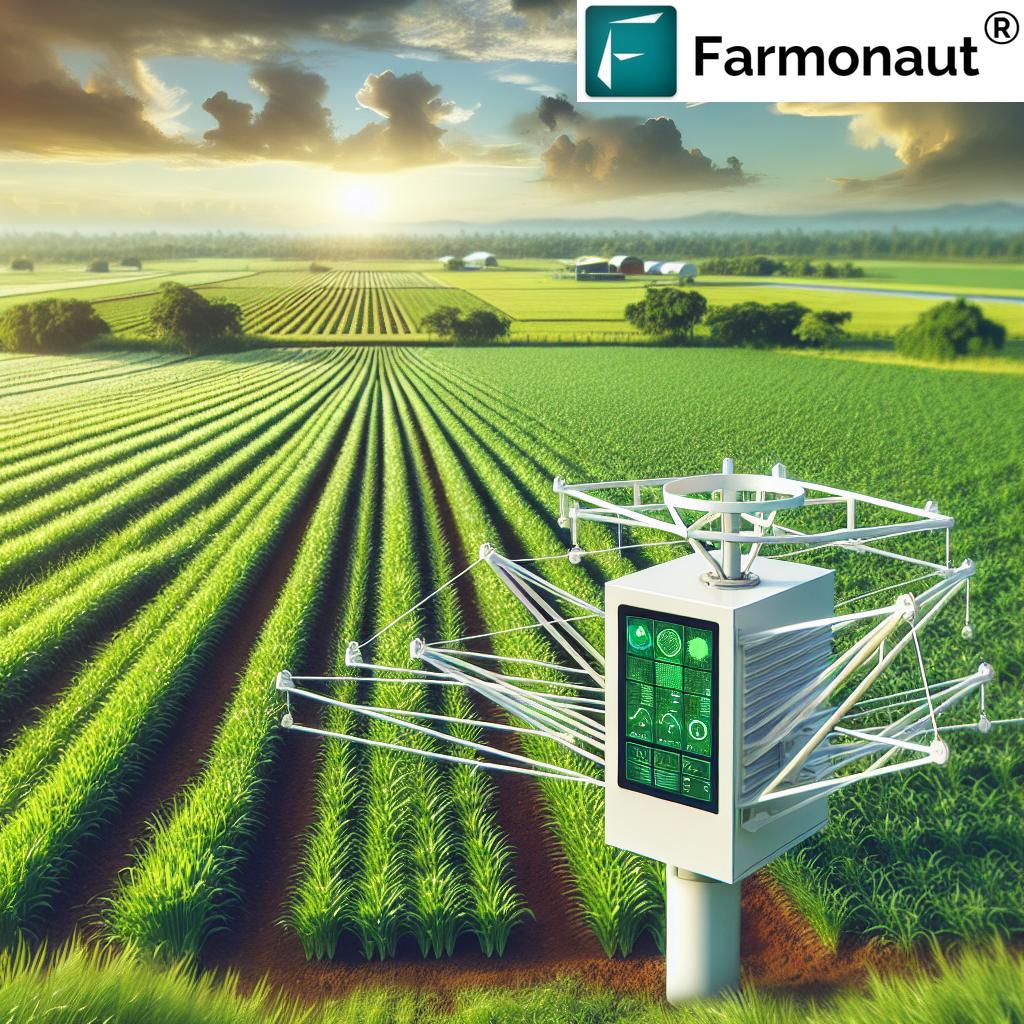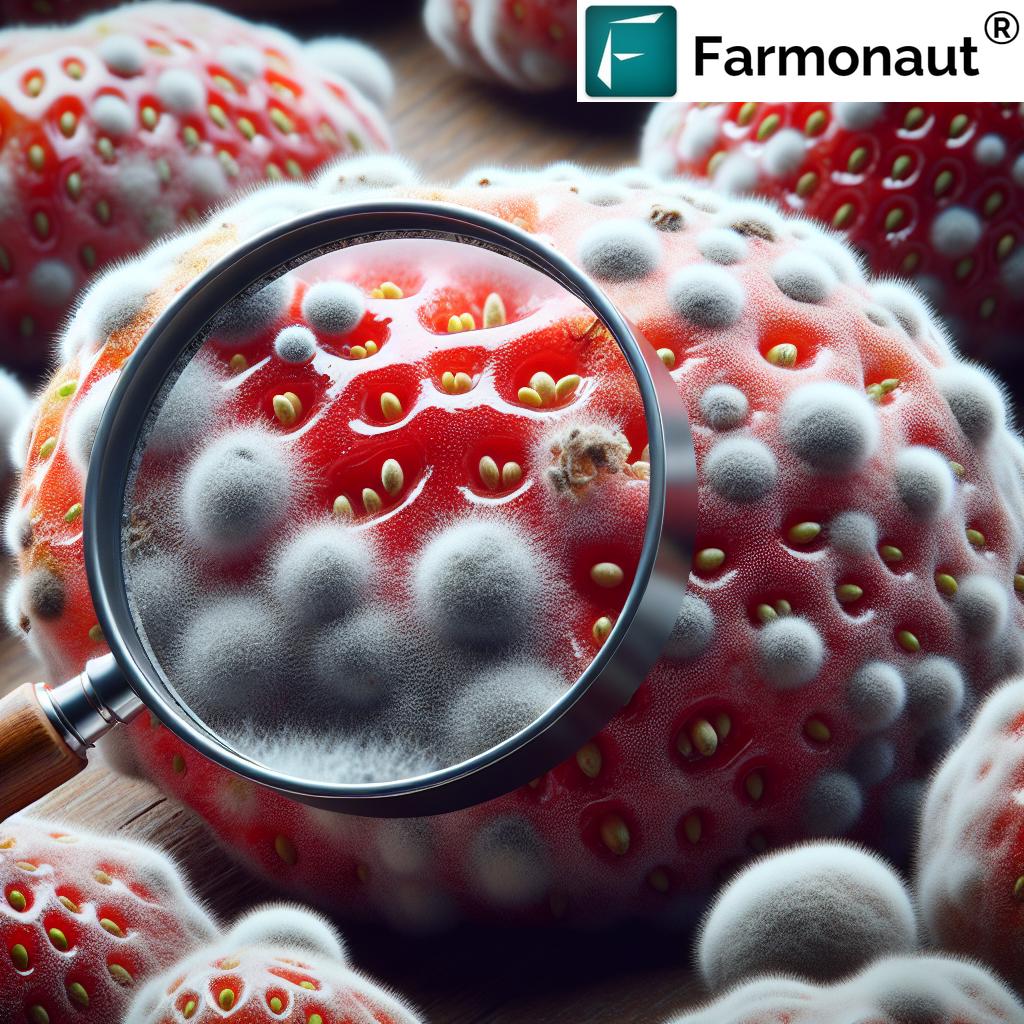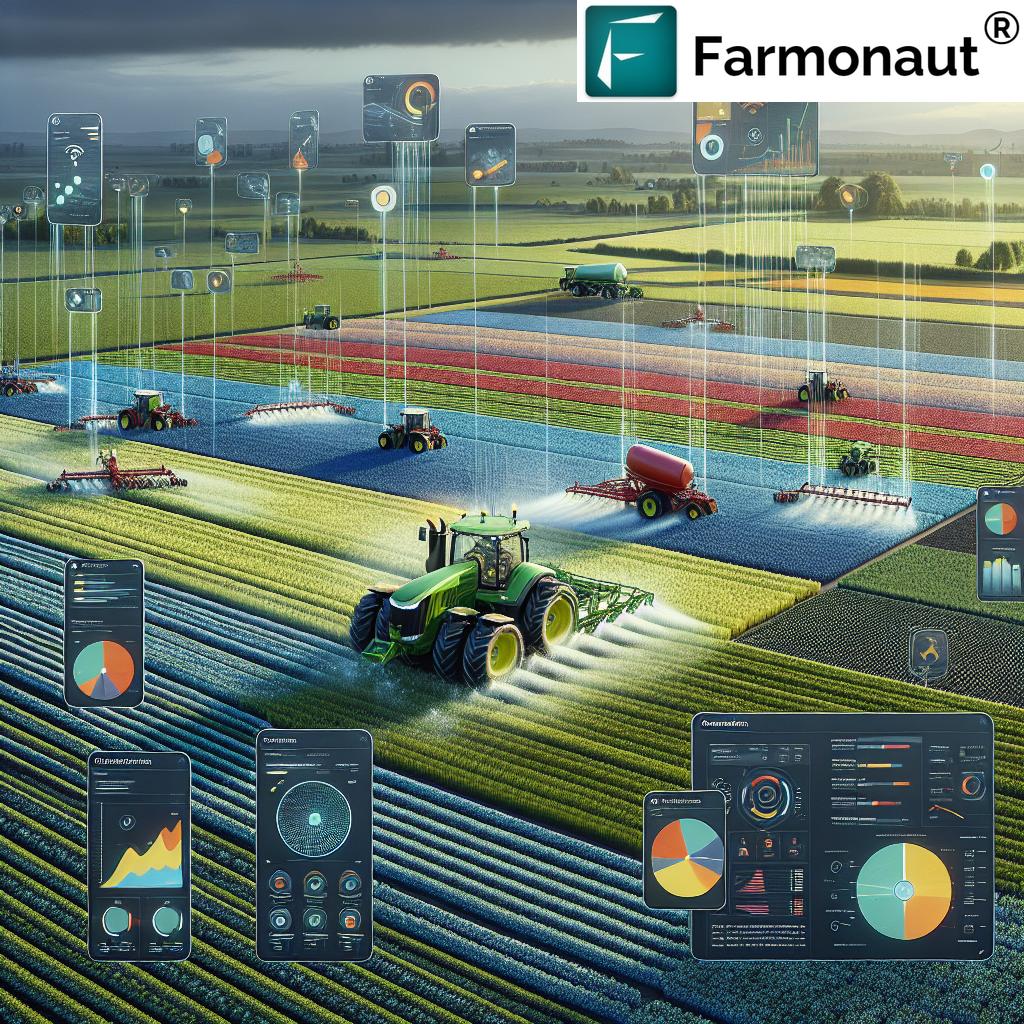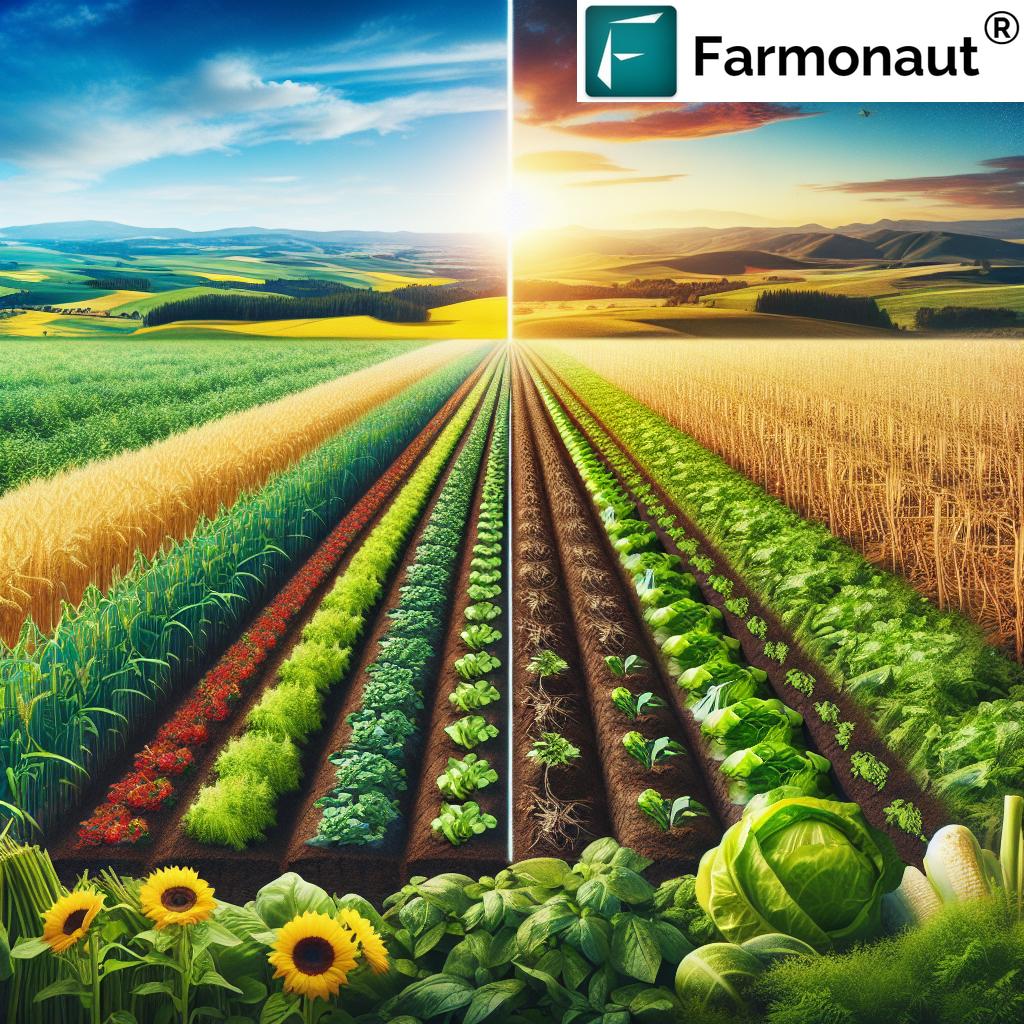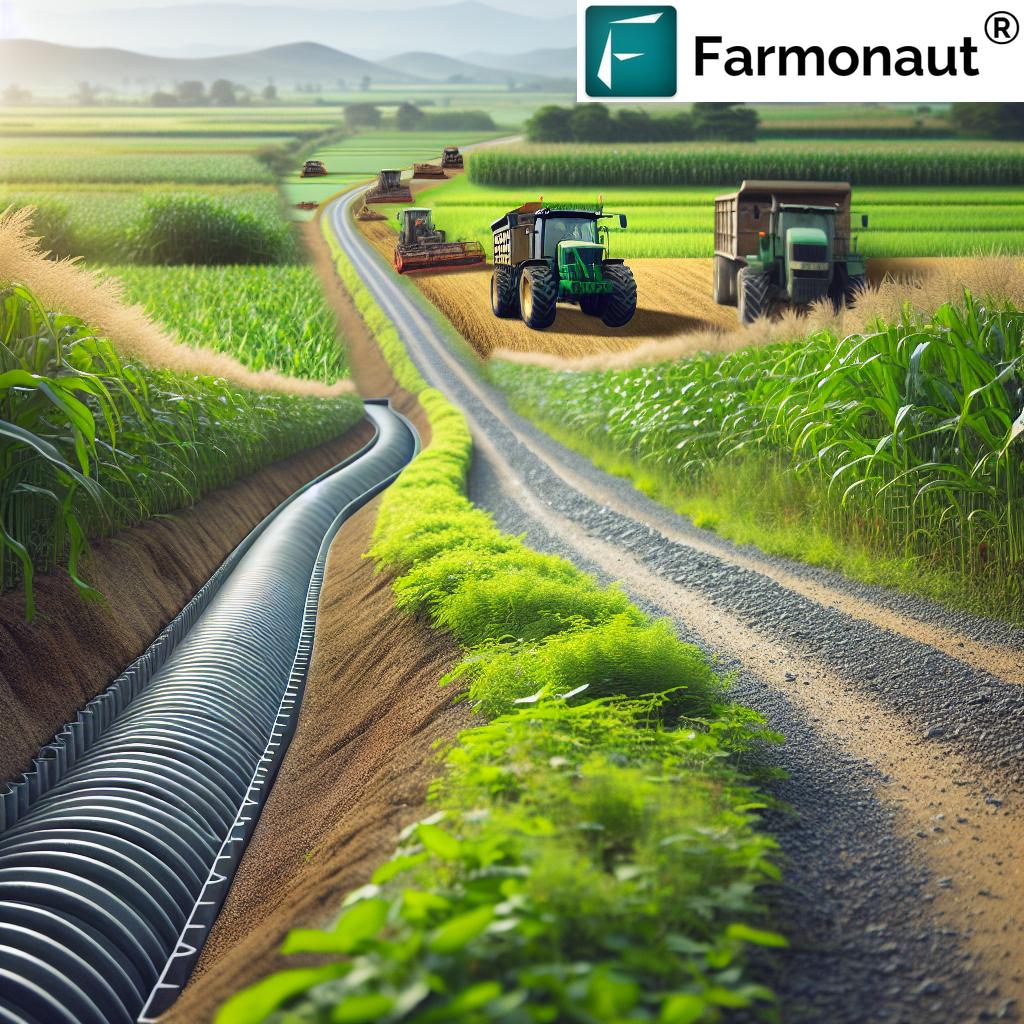Table of Contents
- Introduction
- The Importance of Climate Monitoring in Agriculture
- Trivia
- Technological Advances Revolutionizing Climate Monitoring
- Gallery
- Climate Monitoring in Agriculture: 7 Game-Changing Hacks
- Feature Comparison Table: 7 Game-Changing Hacks
- Farmonaut in Action: Video Insights
- Trivia
- Practical Applications of Climate Monitoring in Agriculture
- Challenges & Considerations in Climate Monitoring
- Farmonaut: Making Precision Agriculture Accessible
- The Future of Climate Monitoring in Agriculture
- Farmonaut Subscriptions
- FAQ
- Conclusion
Climate Monitoring in Agriculture: 7 Game-Changing Hacks
Climate change is rewriting the rules of agriculture. As farmers around the globe grapple with unpredictable weather patterns, shrinking resources, and rising sustainability demands, one solution stands out: climate monitoring in agriculture. Our ability to leverage advanced technologies, and implement precision agriculture technologies, arms us with the actionable data needed to transform traditional crop management practices.
In this comprehensive guide, we’ll explore the importance, technologies, and practical benefits of climate monitoring, before unveiling 7 game-changing hacks that are transforming farming, forestry, and sustainable land management worldwide. From advanced weather data and satellite imagery to the integration of AI and blockchain, we’ll show you how the future of food security and sustainability is being shaped—today.
The Importance of Climate Monitoring in Agriculture
Every farmer, agribusiness, and policymaker knows this: Our agricultural productivity and future food security hinge on climatic conditions. Temperature, precipitation, humidity, soil moisture, and extreme weather events directly impact crop growth, soil health monitoring, and the overall success of farms across varied landscapes.
- Yield Optimization: Accurate climate monitoring enables us to tailor irrigation management systems, fertilization, and pest control measures, resulting in efficient resource use and heightened yields.
- Resilience & Sustainability: With knowledge of microclimates and seasonal variations, we can select resilient crop varieties and optimize planting schedules, boosting resistance to climatic stresses.
- Protection & Proactivity: Leveraging real-time agricultural weather data lets us deploy early warning systems for farmers, providing timely alerts for adverse conditions and enabling proactive steps to protect crops and livestock.
- Environmental Stewardship: By integrating sustainable practices, we not only enhance productivity but also minimize environmental impact—crucial for future generations.
“Over 70% of farmers using climate monitoring tech report increased crop yields within the first two seasons.”
Technological Advances Revolutionizing Climate Monitoring
The last decade has seen a revolution in agricultural technology. Today, innovative monitoring systems and data-driven solutions offer us granular insights into weather, soil, vegetation, and farming operations. Here’s how technology is transforming how we farm:
Automatic Weather Stations (AWS)
AWS collects real-time data on temperature, humidity, wind speed and direction, rainfall, and solar radiation. This actionable information is crucial for predicting extreme events, planning harvests, and maintaining crop health.
- Supports precision agriculture technologies through microclimate awareness.
- Improves the accuracy of irrigation and fertilization practices.
IoT Sensors & Remote Devices
Internet of Things (IoT) sensors are scattered across fields to monitor localized temperature, soil moisture, pH, and humidity variables in real time.
- Enable data-driven decisions and precision interventions.
- Minimize resource waste by targeting water and nutrient delivery.
- Enhance early detection of disease and pest outbreaks.
Satellite Remote Sensing in Agriculture
Satellites offer comprehensive, field-scale, and region-wide climate and vegetation data.
- Track soil moisture, crop health (NDVI), and land use changes on a massive scale.
- Essential for planning, policy-making, and supporting sustainable land management.
Artificial Intelligence & Advanced Analytics
AI in farming analyzes complex datasets from satellites, sensors, and field records.
- Predicts weather events, optimizes crop management practices, and recommends timely actions for problem-solving.
- Learns seasonal and field variability, enabling continuous improvement in management systems.
Gallery: Climate Monitoring in Agriculture
Climate Monitoring in Agriculture: 7 Game-Changing Hacks
Implementing these seven hacks empowers us to make informed, timely, and precise decisions that substantially boost productivity, efficiency, and sustainability.
1. Automated Weather & Environmental Sensing
- Leverage IoT sensors, AWS, and on-field micro-stations to monitor temperature, wind, humidity, and rainfall.
- Aggregate agricultural weather data for nuanced field-level planning.
- Enable zone-specific irrigation management systems and input schedules.
For example, by using Farmonaut’s solutions, we can remotely access detailed weather and field conditions via mobile or API integration, resulting in precise in-season adjustments and improved harvests.
2. Satellite-Based Crop & Soil Health Monitoring
- Utilize satellite remote sensing agriculture to track crop health indices (like NDVI), soil moisture, and growth anomalies.
- Early detection of disease, pest outbreaks, nutrient deficiencies, and water stress—enabling timely remedial action.
- With Farmonaut, a simple satellite scan can reveal actionable insights for hundreds of hectares at once, all from your device.
Check out Farmonaut Large-Scale Farm Management for comprehensive, multi-field satellite monitoring and easy management at scale.
3. Precision Irrigation Management Systems
- Combine weather predictions, soil moisture readings, and crop water needs to deliver the exact amount of water, at the right time, every time.
- Reduce waste, avoid over-irrigation, and lower energy and water costs by up to 30%.
- Farmonaut’s real-time alerts and API integrations (API details) allows integration with automated systems, creating closed-loop, high-efficiency irrigation workflows.
4. AI-Based Pest and Disease Forecasting
- Apply AI in farming by correlating multi-year weather and satellite datasets to predict pest and disease risks with high accuracy.
- Receive timely, location-specific warnings and suggested control measures to safeguard yields.
- Farmonaut’s Jeevn AI Advisory delivers custom pest and disease alerts on your smartphone, streamlining daily management decisions.
5. Data-Driven Fertilization and Nutrient Management
- Integrate soil health monitoring, satellite imagery, and predictive models to fine-tune fertilization schedules, maximizing nutrient use efficiency.
- Ensure optimal crop growth, minimize runoff, and boost sustainability with targeted, data-backed interventions.
- Farmonaut’s data insights guide accurate input application for different soil types and crop stages.
6. Blockchain-Based Traceability Systems
- Combine field-level climate monitoring with blockchain-based tracking for full supply chain transparency and consumer trust.
- Respond to regulatory requirements and premium buyer demands for traceable, climate-smart products.
- Explore Product Traceability on Farmonaut to secure your supply chain and add value to every harvested kilogram.
7. Carbon Footprint Monitoring and Sustainability Tracking
- Continuously collect climate and activity metrics—fuel used, inputs applied, yields—and analyze the farm’s environmental impact.
-
Lower emissions, improve resource management, and demonstrate sustainability credentials for market advantage.
- Try Farmonaut’s Carbon Footprinting to monitor, manage, and report farm-level emissions and sustainability KPIs effortlessly.
Feature Comparison Table: 7 Climate Monitoring Hacks
| Hack Name | Technology Used | Est. Yield Improvement (%) | Sustainability Benefit | Cost Efficiency ($/hectare) | Ease of Implementation (1-5) |
|---|---|---|---|---|---|
| Automated Weather & Environmental Sensing | IoT, AWS, Field Sensors | 10–18% | Resource efficiency, risk mitigation | $15–$30 | 4 |
| Satellite-Based Crop & Soil Health Monitoring | Satellite Imaging, Cloud Analytics | 12–25% | Reduced inputs, loss prevention | $6–$12 | 5 |
| Precision Irrigation Management Systems | IoT, Weather APIs, Automation | 14–22% | Water savings, lower leaching | $10–$20 | 4 |
| AI-Based Pest & Disease Forecasting | AI, ML, Weather & Satellite Data | 10–19% | Fewer pesticide applications | $7–$15 | 4 |
| Data-Driven Fertilization Management | Soil Sensors, Satellite Data, Predictive Models | 13–21% | Minimize nutrient runoff | $9–$18 | 4 |
| Blockchain-Based Traceability | Blockchain, Cloud, IoT | 5–10% | Supply chain transparency | $3–$10 | 3 |
| Carbon Footprint Monitoring | APIs, Environmental Sensors, Satellite Data | NA (Indirect through sustainability) | Environmental compliance, access to green markets | $4–$11 | 5 |
Farmonaut in Action: Video Insights
“Precision agriculture can reduce water usage by up to 30% through advanced climate data analysis.”
Practical Applications of Climate Monitoring in Agriculture
Incorporating advanced monitoring systems into farms and forestry projects is more than just adopting new tech—it’s about unlocking real-world benefits we can see season after season.
-
Precision Agriculture Integration: Mapping microclimates and field variability with GPS & satellites, enabling targeted interventions that outperform blanket approaches.
See how our Large-Scale Farm Management platform can centralize your operations. - Resource & Water Management: Informed irrigation management systems ensure every drop counts. Data-driven scheduling saves water and maximizes crop uptake.
- Soil Health Monitoring: Tracking soil temperature, moisture, and nutrient variation—right from your device. Make smarter planting & input decisions for every corner of your field.
- Pest & Disease Early Detection: Use predictive feeds from weather, AI, and IoT for timely, precise pest control, minimizing chemical use and residue.
-
Supply Chain Integrity: Blockchain integration builds consumer trust with product traceability.
Explore our Product Traceability service. -
Carbon & Sustainability Tracking: Meet compliance and market demands with real-time farm-level carbon footprinting.
Our Carbon Footprinting tools make it seamless. -
Climate-Driven Financial Services: Use satellite-verified data to access crop loans and insurance faster, more accurately.
See our solutions for Crop Loan and Insurance processes.
Challenges & Considerations in Climate Monitoring
Adopting cutting-edge climate monitoring in agriculture isn’t without hurdles. Let’s address the main challenges and our suggested approaches:
-
Data Integration:
Unifying AWS, IoT, and satellite data into usable insights requires robust backend systems and skilled staff. Farmonaut’s API provides seamless integration (API, Developer Docs). -
Cost Constraints:
Upfront investment for IoT and data platforms may challenge smallholders. Satellite solutions like Farmonaut offer subscription models to lower the barrier. -
Data Interpretation:
Not everyone is a data expert. That’s why Farmonaut’s AI-based advisory turns complex metrics into simple, actionable recommendations. -
Rural Infrastructure:
Reliable power and internet can be limiting. Mobile-friendly, offline-capable apps reduce dependence on constant connectivity. -
Privacy & Security:
Protecting sensitive farm and climate data is paramount. Blockchain-backed recordkeeping and secure access protocols maintain data integrity.
Farmonaut: Making Precision Agriculture Accessible
We believe that every farmer—regardless of size, region, or crop—deserves access to the world’s best agricultural technology. Farmonaut delivers satellite-powered, AI-driven, and blockchain-integrated services across platforms:
- Real-Time Crop & Soil Health Monitoring: Monitor vigor, NDVI, soil moisture, and more without on-field hardware—just your phone, web browser, or device.
- Jeevn AI Advisory: Get personalized, data-driven recommendations on weather, planting, input optimization, and risk alerts with zero technical expertise needed.
- Fleet & Resource Management: Optimizing farm and transport operations reduces waste and delivers efficiency. For agribusiness and cooperatives, discover our Fleet Management solutions.
- Blockchain-Verified Traceability: Build trust and capture markets with verifiable crop and product histories.
- Carbon Footprinting Tools: Monitor environmental impact and support compliance, branding, and market access.
- API & Integration: Build your agritech, fintech, or government system with up-to-the-minute climate and crop data from Farmonaut’s trusted API.
- Plan for Crops, Forests, and Plantation: From traditional farming to forest and plantation management, Farmonaut enables climate-smart decisions at all scales. Try Farmonaut for Plantation & Forest Advisory.
Note: Farmonaut is not an online marketplace, manufacturer or seller of farm inputs/equipment, or a regulatory body. Instead, we provide data-driven technological solutions for all stakeholders involved in precision agriculture.
The Future of Climate Monitoring in Agriculture
The journey toward resilient, productive, and sustainable farming is just beginning. Looking ahead, our vision includes:
- Affordability for All: Making climate monitoring in agriculture accessible to every grower, especially smallholders, by lowering costs and simplifying technology.
- Data Standardization: Establishing open, universally accepted protocols for climate and field data collection, sharing, and interpretation.
- Capacity Building: Providing structured training and hands-on support so everyone—from individual farmers to large enterprises—can use data effectively.
- Supportive Policy: Encouraging governments to integrate climate monitoring technologies in agricultural subsidy, insurance, and emergency response programs.
- Scalability for Every Stage: Designing flexible solutions that grow from a few acres to national-scale monitoring, with Farmonaut’s API and multi-layered platform.
Together, by leveraging advanced analytics, satellite imaging, AI, and precise weather data, we can transform global agriculture—delivering abundant, climate-smart yields, and securing the global food supply.
Want to build your own agri-solution or integrate weather/crop data? Explore the Farmonaut API and our Developer Docs.
Farmonaut Subscriptions
Choose an affordable, scalable plan to unlock full access to satellite-driven insights, precision weather, and AI-powered crop health monitoring—on any field, anywhere, anytime.
FAQ: Climate Monitoring in Agriculture & Farmonaut
Q1: What is climate monitoring in agriculture?
Climate monitoring in agriculture involves collecting, analyzing, and using real-time data on weather, soil, and environmental variables to enhance crop growth, yield, and sustainability. It empowers farmers to make informed decisions about irrigation, fertilization, pest control, and more.
Q2: How do precision agriculture technologies boost yields?
Precision agriculture technologies—such as IoT sensors, satellite remote sensing, and AI—provide precise, field-specific data. This lets farmers optimize input use, tailor interventions, and respond rapidly to climate or pest risks, resulting in improved crop yields and reduced waste.
Q3: Why should I use satellite imaging and AI-based advisory?
Satellite imaging gives comprehensive, real-time views of crop health and soil status. AI-based advisory tools, like Farmonaut’s Jeevn AI, analyze this data and deliver clear, actionable recommendations, even if you have no technical background—helping maximize your returns efficiently.
Q4: Can I access Farmonaut’s services on my smartphone or tablet?
Yes! Farmonaut offers fully mobile-friendly web and native apps for both Android (Download for Android) and iOS (Download for iOS).
Q5: How does Farmonaut help with sustainable land management?
Farmonaut assists in sustainable land management by tracking crop health, soil moisture, carbon emissions, and product traceability. This technology helps optimize resource use, comply with environmental standards, and build a resilient farming operation.
Q6: Is my farm data secure with Farmonaut?
Absolutely. Farmonaut uses secure cloud storage and, where required, blockchain for data verification. Your detailed farm and climate data is accessible only to you (unless you choose otherwise for supply chain transparency).
Q7: I run multiple large farms. Can Farmonaut handle large-scale farm management?
Yes. Farmonaut’s Large-Scale Farm Management solutions are designed for multi-field, plantation, and enterprise use—centralizing data and enabling organization-wide monitoring and optimization.
Q8: How often is satellite data updated?
On the Farmonaut platform, satellite data for crop and soil monitoring is updated as frequently as every 3-5 days, depending on weather and satellite path, ensuring you have near-real-time information at your fingertips.
Q9: Where can developers integrate Farmonaut’s API?
Developers can use Farmonaut’s robust API in agritech, fintech, research, and enterprise platforms. Full details and documentation are available here: API and Developer Docs.
Q10: Can I monitor forestry and plantation crops as well?
Yes! Farmonaut supports not only conventional crops but also forestry, plantation, and specialty crops. Try it out via Farmonaut’s Crop Plantation & Forest Advisory.
Conclusion: Transforming Agriculture for a Resilient Future
Climate monitoring in agriculture is no longer a luxury—it’s a vital component of modern farming, forestry, and sustainable land management. By embracing precision agriculture technologies and integrating satellite, IoT, AI, and blockchain tools, we are empowered to optimize yields, reduce costs, and minimize environmental impacts.
Together, as we face increasing climatic uncertainties, our investment in data-driven crop management practices is our best insurance policy—helping us feed the world sustainably, profitably, and resiliently. Farmonaut’s commitment is to make these innovations accessible and affordable for every farmer, everywhere.
Start your journey with Farmonaut today—because every field, every farm, and every season deserves the edge only technology can provide.




